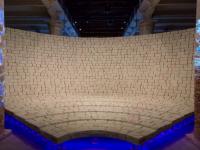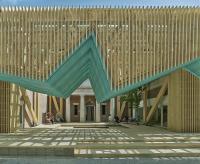MONOLITH in Fukuoka
Japan
Located just a 6-minute walk from Kurume Station, this assisted living facility stands in the heart of the city. While assisted living facilities are often built in suburban areas to reduce land costs and provide quieter surroundings, the urban location of this facility offers superior access to public transportation and medical services. This convenient location also facilitates family visits, emphasizing a design that nurtures connection with the local community.
The building is compactly situated on the southern side of the site, with a one-way traffic flow to ensure smooth vehicle access. To facilitate pick-ups and drop-offs for residents and visitors, a large canopy measuring 11 meters by 6 meters has been installed, providing comfortable access to vehicles even in rainy weather. By leaving part of the site open, ample parking and a garden space accessible to the community were created. The L-shaped site is open to the surroundings, allowing free passage through the area.
Design considerations emphasize ensuring that residents experience outdoor air, natural light, and sounds, fostering a sense of connection with both time and community. The garden features 36 squares of varying sizes, from 1.6m to 4.6m on each side, incorporating elements such as decks, lawns, flower beds, benches, water features, and a single pavilion. As residents wander through the garden, they can enjoy the changing seasons.
The cube-shaped pavilion features rhythmic openings that create a beautiful contrast of light and shadow, captivating residents and visitors alike. This space serves as both a relaxing area and a place that richly stimulates the senses.
The exterior is finished in exposed concrete, with its robust appearance providing peace of mind against earthquakes and other disasters. To soften the concrete’s cold impression, custom formwork was used to create a textured surface. The fine, stripe-like bumps etched into the facade generate consistent shadows, reducing the visibility of dirt compared to smooth concrete and helping to lower maintenance costs. Fly ash concrete was also used to minimize cracking.
The interior is designed with a calm and welcoming atmosphere, using a palette of white and brown tones. In the entrance hall, the exterior’s stripe pattern is recreated in wood, enhancing the continuity of design. While vinyl materials are commonly used in assisted living facilities for ease of cleaning, wood is employed here for handrails and handles, allowing residents to experience the warmth of natural materials.
The main building and pavilion, simple concrete volumes in the form of a tube and a cube, have been transformed into a comforting “MONOLITH” through carefully considered textures and openings, softening the hardness of the concrete and creating a sense of peace for residents and visitors.
I believe I have successfully achieved my goal: creating an assisted living facility where I would feel comfortable entrusting my own parent.
- arkkitehdit
- SAKO Architects
- Year
- 2015
- Team
- Principal Architect: Keiichiro Sako
- Architectural Design
- SAKO Architects
- Interior Design
- SAKO Architects
- Landscape
- SAKO Architects
- Lighting Design
- BONBORI Lighting Architect & Associates, Inc.


















